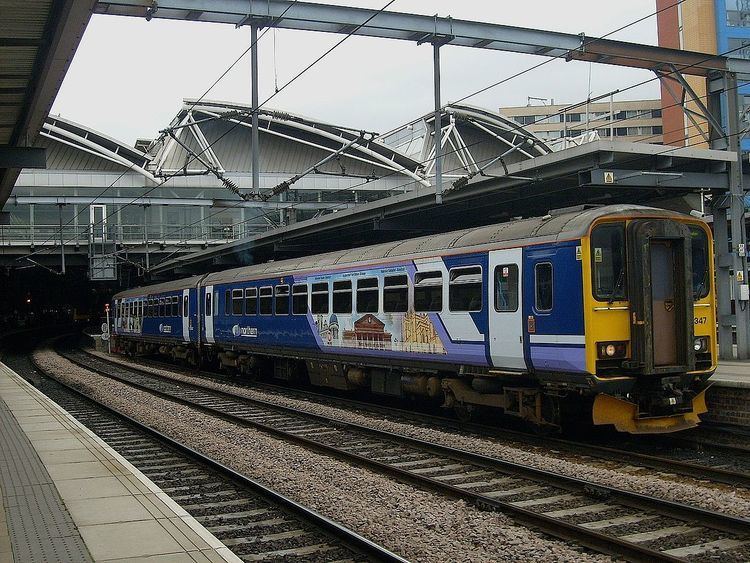In service 1987 - present Replaced First generation DMUs | Family name Sprinter | |
 | ||
Order no. 31057 (DMSL)31058 (DMS) | ||
The British Rail Class 155 is a diesel multiple unit. These DMUs were built by Leyland Bus at Workington (Incorporating some Leyland National bus components) between 1987 and 1988 as part of British Rail's replacement of its ageing diesel fleet which were First-Generation. 42 units were originally built, however only 7 remain; the other 35 units were converted to Class 153 railcars.
Contents
History and description
The Class 155 train is made up of two 23 metre coaches were fitted with Cummins NT855-R5 285HP engines and Voith transmission.
The fleet was part of the "Super Sprinter" build (the other half of which was the Class 156 fleet) and was built by Leyland with a similar construction technique to the Pacers, with extensive use of Avdel rivets holding pre-formed panels together in a lightweight body on a welded floor assembly. The large number of windows makes the vehicles look unusually long, although the fact that the vehicles are very long for such a lightly built body has led to a slight sag being apparent in certain coaches.
Introduction was rapid, but teething troubles soon emerged. The units were the first BR DMUs with sliding-plug automatic doors which closed to provide a smooth bodyside rather than sliding back into the bodyshell (the system used with 150s and 151s). These doors did not work properly and there were reports of them opening while the trains were in use. Consequently, the fleet was taken out of use and modified, with the 156s taking over their diagrams.
Following rework the fleet performance improved substantially. An emerging requirement for replacement rural lines stock saw BR decide to convert the Regional Railways fleet into single-cars to replace the elderly 121 and 122 "Bubblecar" units. These single-car sets, introduced 30 years previously, had been threatened with withdrawal and replacement by the Pacer fleet, although the Pacers had proved to be unable to work the sharply-curving steeply-graded branchlines involved. Instead the Pacers were moved to replace a number of Class 150s, the 150s took over certain 156 diagrams, and the 156s took on the 155 services which were not handed over to the new Class 158s. The 155s emerged from the workshops as single car Class 153s, and were put to work augmenting two car units and on the quiet Cornish, Welsh, North-Western, Norfolk and Lincolnshire branch lines. They do not operate North of the Scottish border. However, West Yorkshire Passenger Transport Executive refused to allow the seven units which they owned to be converted, and these were merely modified to operate reliably in original form. The conversion to single car units was notable for not requiring any external doors to be moved, although this has led to the No.2 cab being unusually cramped, despite being extended into the vestibule area.
The units were equipped with a large parcels locker. This is because when the units were constructed in the 1980s, a large quantity of local parcels traffic was still conveyed by rail under the brand Red Star Parcels. This fell out of use in the period leading to rail privatisation, and the large areas are now used as luggage space (both on Class 153 descendants and the surviving 155 units). They are similar in interior to the Class 156 DMUs built at the same time.
Later units
Seven further Class 155 units, (155341-155347) were built in 1988 for West Yorkshire Passenger Transport Executive (WYPTE) for MetroTrain services, and remain today in their original formation.
Operations
Before the original units were disbanded, they were largely based in the West Country, at Cardiff Canton and surrounding depots, and used on local and regional services in Wales and the South West, into Birmingham New Street station as well on the longer distance services.
The seven surviving units are all currently based at Neville Hill Railway Depot and operate services mainly on the Caldervale Line and also the Harrogate Line, between Leeds, Harrogate and York.
The units were originally painted in the Regional Railways livery, or in the case of the Leeds-based units, in the carmine and cream West Yorkshire PTE livery. The surviving units have, they have undergone an internal and external revamp, with all units now carrying the livery of their former operator, Northern Rail with a small element of Metro branding retained. The first to be repainted was 155346 in August 2006.
